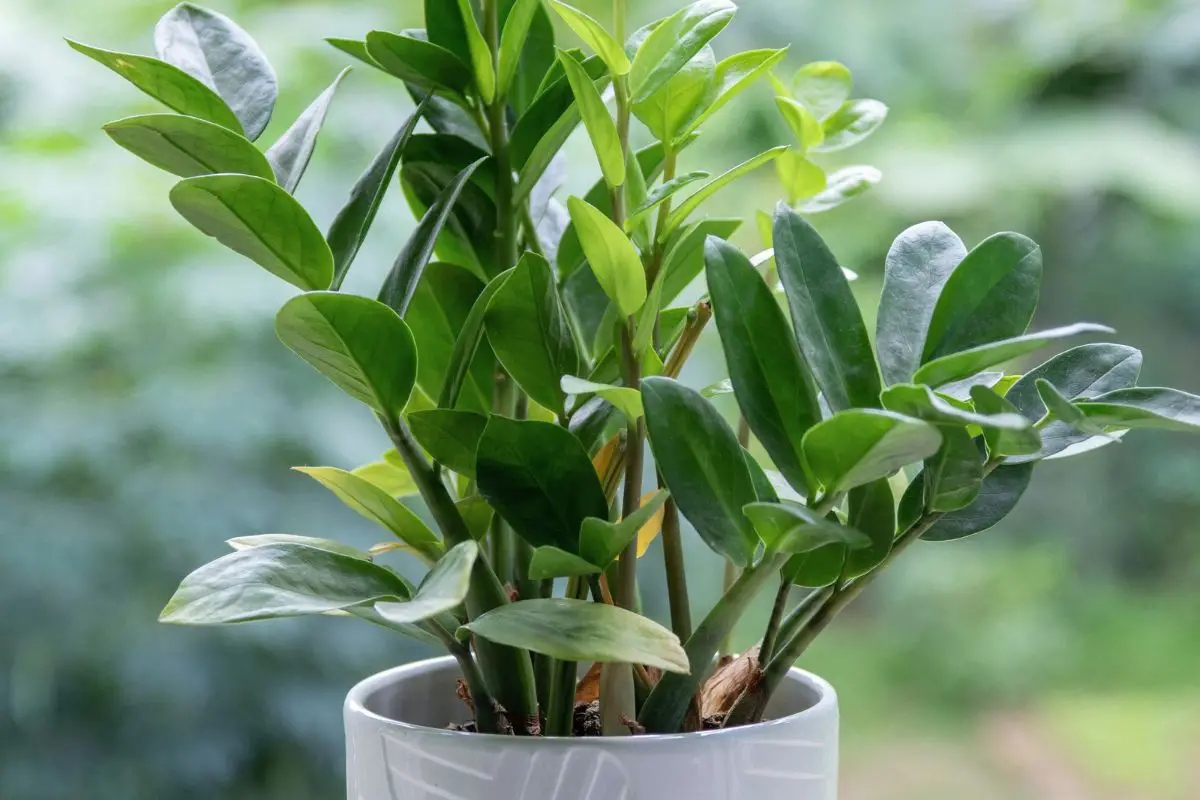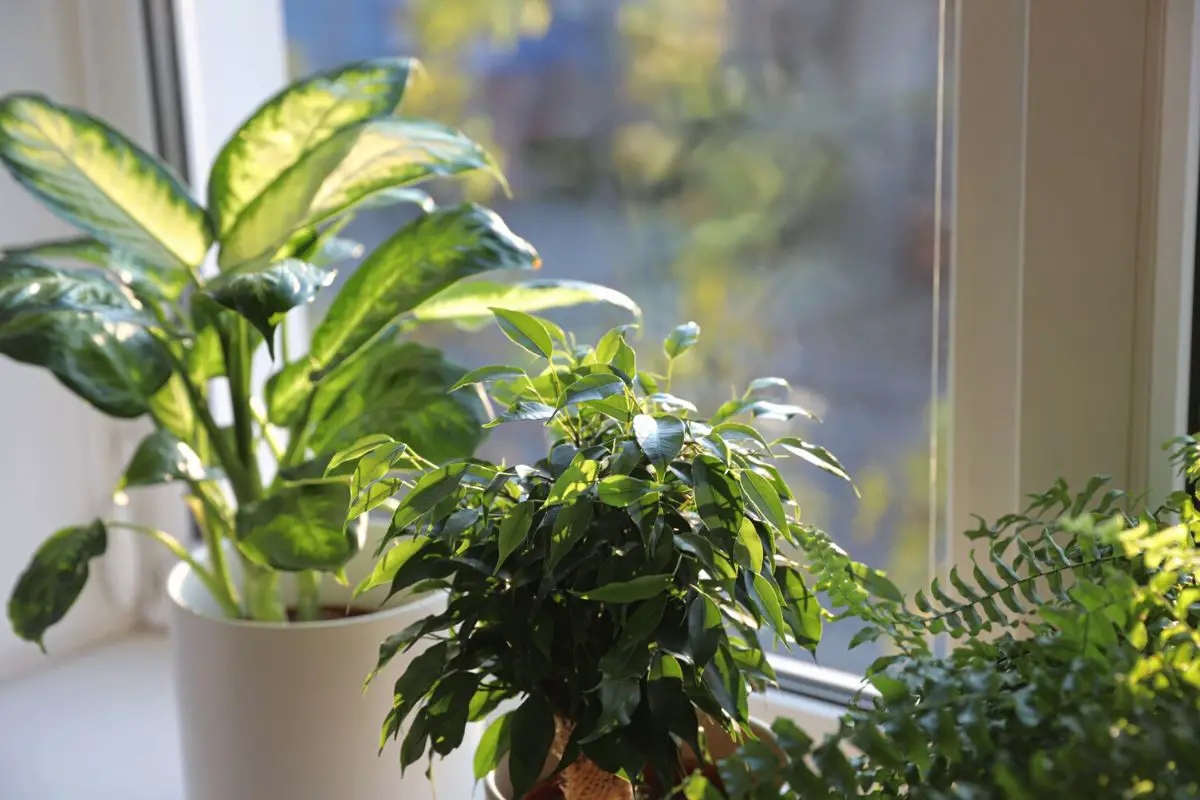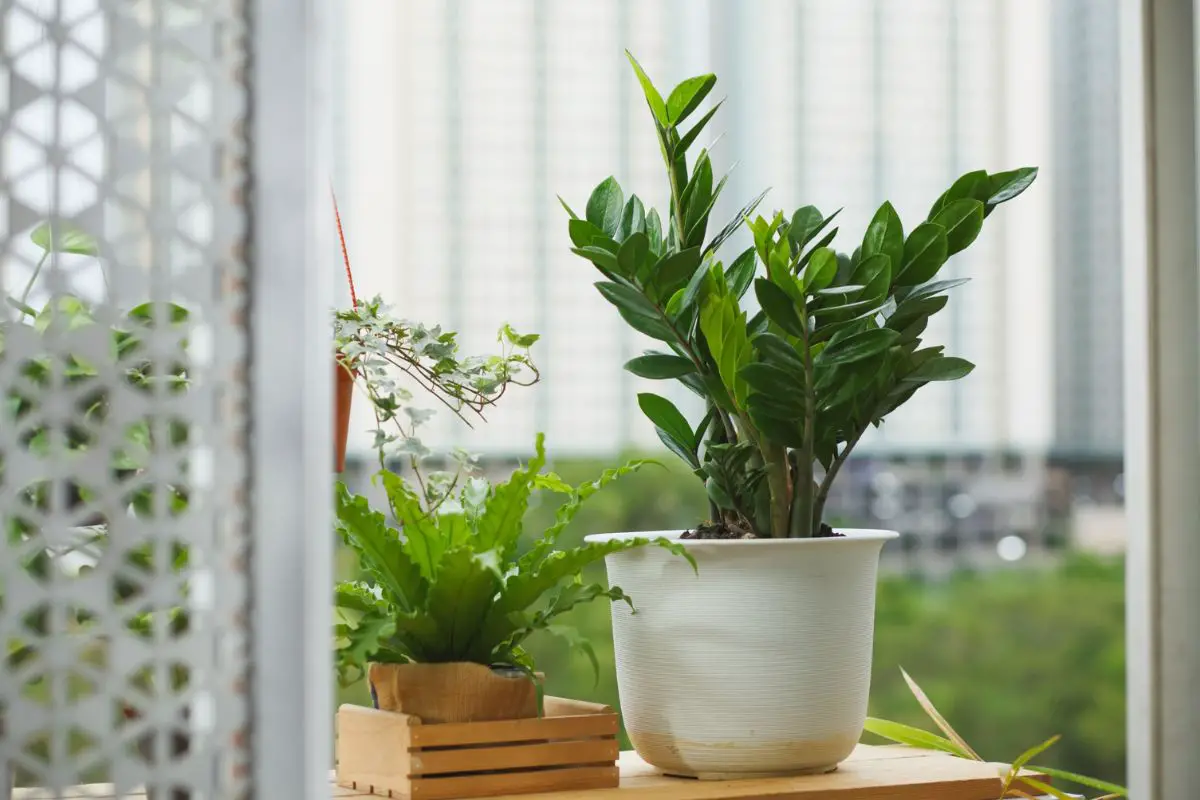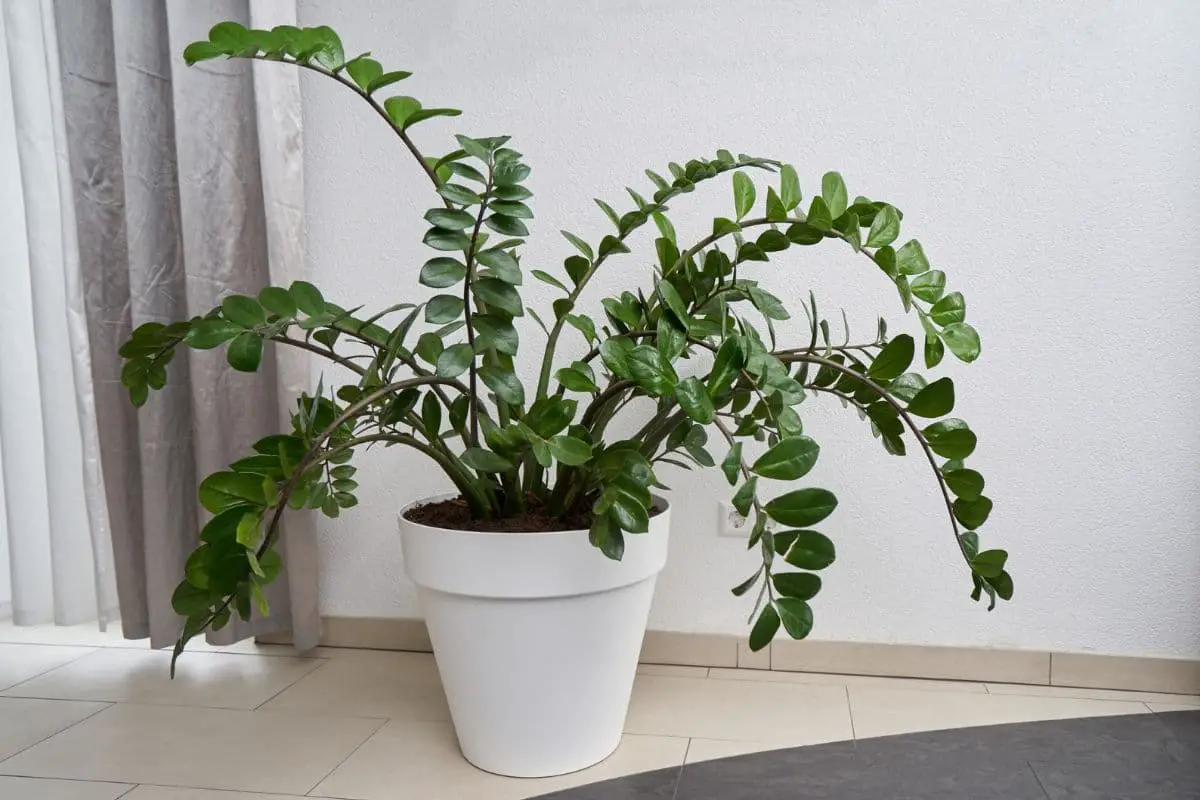ZZ plants are an excellent choice for beginner gardeners because they require low maintenance and can grow in any home. They’re perfect for homes and offices with limited natural light sources because they will keep growing, even with artificial lights.
ZZ plants thrive in dappled sunlight because the tall tree canopies in their native habitat filter the light. They’re sensitive to prolonged exposure to direct sunlight, which can burn the glossy leaves.
In the rest of the article, I’ll discuss the lighting needs of ZZ plants and how to tailor your home’s light conditions to keep your plant thriving.

ZZ Plants: An Overview
Every aspect of a ZZ plant’s anatomy is a testament to how this plant has adapted too well to harsh conditions other plants will likely not tolerate: drought and low light.
Zamioculcas zamiifolia, or ZZ plant, comes from shady forests of East or South Africa, where there’s sandy soil and scarce rains.
The plant developed fleshy roots and thick rhizomes or bulbs to quickly absorb and store moisture when it rains. The waxy leaf coating also prevents rapid moisture loss.
The taller trees and shrubs block the sun and ZZ plants receive only dappled or filtered light. This low-light condition slows down metabolic activities, further allowing ZZ plants to preserve moisture.
The leaves take on a darker emerald hue due to the higher concentration of chlorophyll to maximize the absorption of limited sunlight. These anatomical adaptations to their native environment make ZZ plants suitable as indoor plants.
ZZ plants dislike prolonged exposure to bright, unobstructed light. Intense sunlight can degrade the chlorophyll, turning ZZ leaves yellow before becoming brown and crisp. Conversely, insufficient light can lead to pale green or almost yellow leaves.
It’s important to understand a ZZ plant’s light requirements to enjoy its vibrant green leaves.
Light Requirements
Zanzibar—and other regions of Tanzania where ZZ plants are abundant—is geographically close to the equator. The region receives an average of 8 hours of high-intensity sunlight daily. The US, on the other hand, is in the northern hemisphere with less intense sunlight.
Therefore, 8 hours of dappled sun in their native habitat is more intense than a full day of dappled or filtered sunlight in American homes.
Ideal Light Conditions
A good rule of thumb is to find a spot in your home that receives bright, indirect light for at least 8 hours daily.
The sweet spot for my ZZ plants is around 3-4 feet (0.9-1.2 m) from my eastern window, which receives direct sunlight for only 1-2 hours in spring and summer. With proper care, my plant produced flowers, which clearly indicated it was happy.
I’ve also tried placing my ZZ plants in lower light conditions (i.e., next to a northern window), and they still appear healthy—albeit with slightly paler leaves, no flowers, and slower growth.

Measuring Sunlight Exposure
If you are planning on a large indoor plant collection, it helps to understand the natural light conditions in your home. You can do this by measuring the sunlight exposure in various rooms in your home at different times of day.
The process can be as simple as making a sun diary and mapping every hour from sunrise until sunset or using light meters.
Sun Diary and Map
Here’s how to measure and map the sun exposure in your indoor garden:
- Mark the potential spots in the room for plant placement and label them from A-Z.
- Create a table in your diary and list the letters in the first column.
- From the second to the last column, indicate the hours from sunrise to sunset (ideally 10-12 hours).
- Make a symbol or designated marking for each of the following sun exposures: Direct, Bright Indirect, Filtered, Shaded, Deep shade.
- Set an alarm every hour and check the light levels on each spot.
- Mark the spots based on how much sunlight they receive. For instance, the spot right next to an eastern window gets direct sunlight from sunrise until shortly before noon and is shaded in the afternoon since there are no other windows in the room.
It might seem troublesome, but you’ll only have to do it once every season, record it, and use it as a reference every time you add a plant to your collection.
With this information on hand, you can reduce the risk of getting your plant’s lighting needs wrong. You also wouldn’t have to wait for your plant to show signs of stress due to incorrect light conditions.
Light Meters
Digital light meters are handy tools for quickly measuring the light intensity in a given spot in lux or foot candles. They come with a sensor that captures light and transmits the reading through a screen monitor.
You can use the same diary above and indicate the numbers from the digital light meter instead of the visual observation.
Pro tip: ZZ plants thrive indoors and have better chances of blooming when they receive an average of 100-500-foot candles for 8 hours daily during the growing season.
Using a digital light meter, here’s my observation on the ZZ plant about 3-4 feet (0.9-1.2 m) from my eastern window:
- From spring to early summer: The plant gets 200-400-foot candles for 1-2 hours of direct sunlight in the morning. The value goes down to around 100-foot candles the rest of the morning and 10-25-foot candles in the afternoon.
- In mid- to late summer: The values can rise to 500, 150, and 50, respectively.
- In fall and winter: The skies can get cloudy, and my ZZ plant receives only around 25-100-foot candles in the morning and around 10-foot candles in the afternoon.
On the other hand, the plant next to a northern window gets an average of 25-100 foot candles daily in spring and summer and 10-40 foot candles during the day in fall and winter.
These results indicate just how well ZZ plants tolerate low-light conditions.
Signs of Inadequate Light
Since every home design and light conditions can vary widely, ZZ plants may exhibit distress when placed in a spot with insufficient light.
Here are some symptoms:
- Stems lean toward the window or lamps.
- The sun-deprived areas become leggy and have sparse leaves.
- The leaves are pale green and almost yellow.
- The plant has stunted growth (no significant growth, even during spring or summer).
ZZ plants typically grow more slowly in low-light conditions. So, if your plant’s stems are growing unusually long and leaning toward the light source, it means your plant needs brighter light.
Effects of Too Much Light
ZZ plants tolerate low light better than too much direct sunlight.
The effects of excessive sunlight include:
- Stems leaning away from the light source
- Brown and crisp spots on sun-exposed leaves
- Yellowing leaf tips that eventually turn brown (similar to dehydration)
- The intense sunlight and heat can burn a hole through the leaves.
As I mentioned earlier, my ZZ plant does great with at most 2 hours of direct sunlight daily. I have to rotate the pot by 90° weekly, or the leaves start to turn yellow.
In lower light conditions, you can get away with turning the pot only at watering, which is typically once every 2-3 weeks during the growing season.
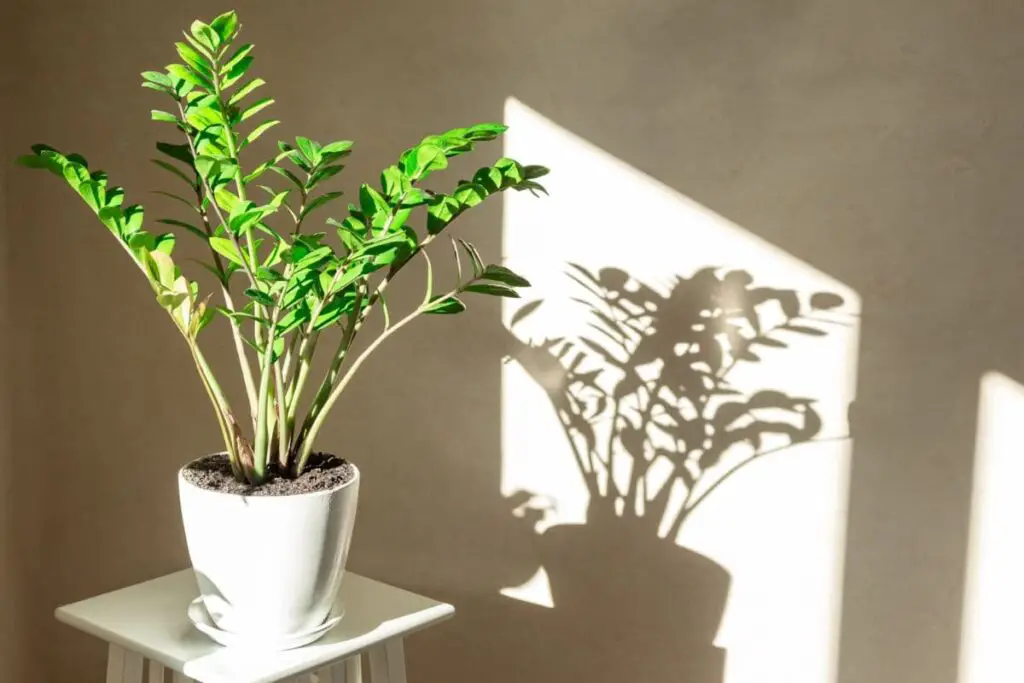
Optimizing Light Conditions
Here are some ways to tailor your natural home lighting conditions for optimum ZZ plant health:
Finding the Perfect Spot Indoors
Depending on your home design, you can choose from the recommended spots for ZZ plants:
- 4-8 feet (0.9-1.5 m) from an unobstructed eastern window if there are no other windows in the room. If you want to move your plant closer to the window, you must increase the watering and rotation frequency accordingly to prevent dehydration and leaf scorch.
- A spot with bright, indirect light all day if there are multiple windows in the room
- 4-8 feet (1.2-1.8 m) from a curtained western or southern window. The afternoon sun is more intense and can burn ZZ plant leaves. On the other hand, southern windows receive sunlight throughout the day, which can be too much for a ZZ plant.
- A spot right next to a northern window
Even constantly dark corners that don’t receive natural light or rooms without windows can accommodate ZZ plants.
You can provide your ZZ plant sufficient light with the following tips:
- Place a mirror in a spot where it can receive sunlight and reflect it toward the dark corners. To be safe, you must rotate your plant regularly in case the reflected light is high intensity, especially from a western window.
- Paint the wall opposite the dark corners white. These walls will absorb a bit of light and reflect the rest throughout different parts of the room.
- Install a 40-watt LED or fluorescent lamp about a foot (30 cm) directly above the ZZ plant and keep it on for 10-12 hours a day. Choose a fixture that cups or encases the sides of the bulb or lamp to ensure the light shines vertically over your plant instead of spreading outwards and losing intensity.

Adjusting to Seasonal Changes
As tropical natives, ZZ plants don’t enter dormancy. Less frequent watering, dryer air conditions, and lower light levels may prompt ZZ plants to grow more slowly, but they don’t shed their leaves.
When placed in medium light conditions (100-500-foot candles) in spring and summer, the lower light conditions (25-100) in fall and winter are enough to keep your ZZ plant alive, although less active.
Regular LED or fluorescent lamps in the ceiling can supplement your plant’s light needs in addition to natural light for part of the day.
ZZ plants are generally not fussy about lower light levels outside the growing season. However, if your plant constantly receives less than 25-foot candles during the day in fall and winter, it may become leggy or start leaning.
I don’t recommend using full-spectrum grow lights for ZZ plants because it defeats the purpose of choosing a low-maintenance plant. These lights can also be costly and may increase your energy consumption costs.
Instead, you can place your ZZ plant 3-4 feet (0.9-1.2 m) directly below a 40-watt LED or fluorescent lamp, which is on for 10-12 hours daily during the cold and dry seasons.
Other lamps in the room can send supplementary low-intensity light to your ZZ plant. Overall, these should be enough to give your plant a steady stream of approximately 10-50-foot candles.
Outdoor Considerations
If you have mild summers with temperatures rarely going above 90 °F (32 °C), you can move your ZZ plant outdoors starting in late spring. This will help your plant put out new growth and even produce short spadix flowers at the base.
Here are the steps and tips for temporarily moving your ZZ plant outdoors:
- Wait until the daytime temperatures are steadily above 65 °F (18 °C) and nighttime temperatures don’t fall below 60 °F (15.6 °C).
- Choose a spot that receives dappled sun or partial shade, such as below a dense tree canopy or below the eaves of the roof in an east-facing garden. Avoid moving your ZZ plant outdoors if you have a west or south-facing garden, as the leaves are sensitive to the intense sunlight in these directions.
- Place your ZZ plant outdoors for an hour in the morning and move it back indoors. Increase the duration by an hour a day for 1-2 weeks before completely leaving your plant outdoors for the rest of the warm season.
- Check the soil regularly because it can dry out more quickly outdoors due to the wind and brighter conditions. Water your plant as soon as the top half of the potting mix is dry.
- Keep an eye on your plant’s leaves. If they’re starting to turn yellow, you may need to install a shade cover over your ZZ plant, especially when temperatures are expected to rise over 90 °F (32 °C).
- Move your plant back indoors as nighttime temperatures start falling below 60 °F (15.6 °C).
Final Thoughts
ZZ plants are resilient and don’t require expensive and excessive care, especially with their lighting needs. They’re generally happy with a full day of bright, indirect light and don’t mind lower light levels in offices or north-facing windows.
It can take a few trials and errors to get your ZZ plant lighting right. But once you find the sweet spot for them in your home, you’ll be rewarded with lush green foliage all year round.
Please share your experience with ZZ plants and let us know how they thrive in your local light conditions.

